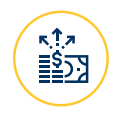As organizations expand their global operations, treasurers continue to consider the impacts of foreign exchange markets, especially given the elevated level of volatility in recent years. As a result, they are increasingly turning to FX hedging to protect their financial results from the impact of currency volatility. By hedging against currency fluctuations, treasurers can help prevent adverse swings in revenue and EPS that are not related to their business’s performance, providing more certainty in the process. In this article, we’ll review the benefits of FX hedging to treasurers, potential considerations, strategies for implementing hedging strategies in the current macro environment, and how to assess whether FX hedging is the right fit for your business.
Benefits of FX hedging to treasurers

REDUCED RISK
Risk can be mitigated with FX hedging, which can act as a bulwark against unfavorable exchange rates, helping to protect finances.

PREDICTIVE CASH FLOW
The cash flow uncertainty associated with FX can make cash flow estimations challenging. Building a hedging program can provide more certainty and insulate organizations from the vagaries of the market. Electing not to engage in FX hedging can place a finance team at a disadvantage if the markets shift, leaving them more vulnerable to volatility.

CONTROL COSTS
For U.S.-based organizations with overseas expenses, moves in FX rates will change the dollar value of their non-dollar currency exposures. This can result in costs far higher than expected in the event that the dollar weakens. The dollar equivalent of euros today could be very differe nt five years from now. If a finance team is locked into a long-term contract to purchase an asset in euros, this differential could have challenging consequences.
Are there any drawbacks to FX hedging?
Level of conviction in future cash flow events
It’s important to have some degree of certainty that those cash flow events are going to occur within the expected time horizon(s) — ‘naked’ hedge without an offsetting underlying exposure. Ensuring robust data and visibility is critical, particularly when you’re looking at longer dated cash flows.
Cost of hedging
FX hedging will often involve a form of cost (often represented by the carry cost of forward points, or premium cost for option products). The first step of assessing the cost of hedging is to quantify the risk that you're trying to mitigate. A cost-benefit analysis (typically in the form of VaR or CFaR) can help treasurers quantify the range of outcomes that are expected (usually within a two standard deviation confidence interval) of being unhedged. To better illustrate this point, here’s an example:
- Let’s say that a worst-case scenario shows you could stand to have an FX loss of $100 million. The second step is to calculate the cost of entering hedges to decrease exposure. In this example, the cost of being fully hedged for the exposure could be $10 million. While the worst-case unhedged scenario may not materialize, you’ll at least have certainty that in a hedged scenario your worst case is capped at $10 million (for protection that you may or may not have needed). This seems favorable to the worst-case unhedged outcome of $100 million.
Approaches to consider when implementing a robust FX hedging program in the current macro environment
Layering in for future cash flow events
When managing future cash flows, such as expected income or expenses over the next two to three years, it’s crucial to consider any uncertainty that comes with long-term financial prospects, especially regarding revenue or cost. Companies often lack complete confidence about these future cash flows due to potential changes and unforeseen events. To mitigate this risk, many companies adopt a strategy for layering in hedges over an extended period. For example, a company might decide to hedge 50% of their expected income two years in advance based on a reasonable level of certainty. As time progresses and the company gains more clarity on the exact amount of future exposure, a treasurer can gradually add additional hedges. This approach prevents the company from becoming over-hedged and ensures that its hedging strategy is flexible. Effective layering in hedging relies on accessing high-quality information and making informed decisions to avoid significant discrepancies between hedge amounts and actual cash flow.
Analyzing the balance sheet
Another area of focus for treasurers when implementing a robust FX program is balance sheet hedging. This type of hedging focuses on managing current financial positions listed on a company’s balance sheet rather than future or anticipated cash flows. These include monetary assets and liabilities in various currencies. To address these concerns, companies typically use shorter-dated hedges, such as one-month trades creating flexibility to adjust hedge levels accordingly. If a company knows its bank account balance is 200 million euros, it might put a one-month derivative hedge in place to cover that amount. In a month, if the balance changes to 150 million euros, the hedge would be adjusted accordingly. This approach adds nimbleness and adaptability to the corporate hedging strategy, ensuring that companies are not tied to specific hedges for extended periods of time.
Derivative selection
Treasury teams have an array of instruments that can be executed as FX hedges. Forward contracts can be utilized to provide certainty and take risk off the table. However, FX options are increasingly being explored in scenarios where there is less certainty of the underlying exposure manifesting (such as when protecting future dated cashflows). Outside of economic considerations, accounting and operational support should be considered when deciding on the appropriate derivative selection.
Is FX hedging right for your business?
The following considerations can help you decide if FX hedging is right for your business:
Composition of foreign currency exposure
Before deciding to integrate FX hedging into your business operations, it’s important to evaluate your company’s exposure to foreign currency. There are often natural offsets that may exist (e.g., payables and receivables in the same currency), which inherently reduce the exposure that requires hedging. In addition, quantifying the magnitude of exposure for the company is important. If foreign currency revenue only equates to 3% of your total earnings, FX hedging may not be worth the effort and resources.
Risk tolerance
Risk tolerance is a crucial factor to consider when determining whether FX hedging is the right strategy for your business. To help understand your company’s risk tolerance, it’s important to ask these questions:
- How much exchange rate fluctuation can your business withstand before it materially impacts financial operations?
- Is your company able to combat potential financial impacts of sudden currency volatility/what does the process look like right now?
- What are the long-term implications on your business if you did not utilize FX hedging?
- What is the cost/benefit profile of the program (how much risk reduction is being achieved through the cost of administering the program)?
Stakeholder alignment
An FX hedging program shouldn’t be instituted in isolation- there should be consultation with other finance groups (Tax, Accounting, FP&A), in addition to auditors, to ensure that the hedging program delivers maximum value. Establishing an FX policy to govern the parameters of a program is often a best practice and can enable treasury teams to be more prepared to execute, even if the need isn’t immediate.
In addition to reducing risk, FX hedging has the potential to control costs and predict cash flows. By taking the time to decide whether FX hedging is aligned with your business priorities and understanding the different FX hedging strategies, you’ll provide your business with a powerful tool that can help inoculate it against unpredictable market conditions.
